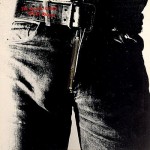It borders on heresy, I know. But I’m not a huge Rolling Stones fan. Probably because of the band’s more blusey sound and roots, I never became wholly enthralled with it. Still, Sticky Fingers, released 38 years ago this week, was the second of four consecutive studio albums that are my favorites in the Stones catalog.
 For me, Sticky Fingers represents a transitional album for the Stones. It is a sign post between the excellent Let It Bleed, released in 1969, and the best Stones album of all time, Exile on Main St., released in May 1972. There’s good reason. One track from Sticky Fingers, “Sister Morphine,” was actually recorded during the sessions for Let It Bleed while a number of the tracks that would appear on Exile had their origination in the Sticky Fingers sessions.
For me, Sticky Fingers represents a transitional album for the Stones. It is a sign post between the excellent Let It Bleed, released in 1969, and the best Stones album of all time, Exile on Main St., released in May 1972. There’s good reason. One track from Sticky Fingers, “Sister Morphine,” was actually recorded during the sessions for Let It Bleed while a number of the tracks that would appear on Exile had their origination in the Sticky Fingers sessions.
Sticky Fingers, like Exile, grabs you from the outset with a wicked guitar riff. Yet the opening licks on “Brown Sugar” at the beginning of Sticky Fingers have become almost iconic. The song remains one of the band’s best known hits and both it and the album reached No. 1 in the U.S. within a month of the LP’s release. But there were other popular tunes, the acoustic ballad “Wild Horses” also hit the singles charts. My personal favorite of the radio cuts is “Bitch,” the flip side to the “Brown Sugar” single. Built almost entirely on a single chord progression that opens with guitar and then is bolstered by the incomparable Bobby Keys and Jim Price on horns. Yet perhaps my favorite cut on the entire album is “Can’t You Hear Me Knocking.” Opening like so many other Stones tunes with a blues-based riff, about half way through the band breaks into a Traffic-like jam featuring an excellent sax solo by Keys and one of my favorite solos by Mick Taylor, who joined the group on guitar during its 1969 tour.
It is somewhat of a surprise commercial radio made “Brown Sugar” a staple. After all, it deals with racial exploitation, slavery and oral sex. Yet the original album cover (which my LP came in) also made a statement, one that left just as little room for speculation. Thanks to an idea from Andy Warhol, it featured an actual working zipper, one which opened to reveal a man’s underwear. While the cover was seen as somewhat problematic for some uptight store owners, it had other problems. According to one account:
…it turned out that during shipment the zipper would press into the album stacked on top of it (invariably damaging “Sister Morphine”); Atlantic Records threatened to sue [cover designer Craig] Braun for all the damage. After getting “very depressed and very high,” Braun came up with the solution; pull down the zipper before the album was shipped — then it would dent only the label. Braun never did figure out how to keep Sticky Fingers from scratching other album covers.
Fortunately, my LP wasn’t damaged by the zipper so I presume mine was shipped with the zipper down. The zipper did, though, cause some damage to other LP covers when pulling it out and reshelving it.
Between the music and the album cover, Sticky Fingers became iconic. Yet it also produced another indelible item. This was the first LP on the band’s own label, so one side of the album sleeve and the label on the vinyl itself carried the Rolling Stones tongue, the first appearance of that logo. It quickly became one of the most widely recognized symbols in the world. How big a deal was the logo? The original was bought an an auction last fall for more than $90,000 — by a London museum.
I have my freedom but I don’t have much time
“Wild Horses,” Rolling Stones, Sticky Fingers







